WP1 – Materials operation conditions and their feasibility studies

Deliverable 1.1 - Process parameters of solar sCO2 Brayton cycle
The goal of this deliverable is to fix the parameters relevant for the heat exchanger design (mass flow, temperatures and pressures). In order to obtain this data, a Brayton cycle needs to be selected. Because this cycle is not commercially applied yet, there are many options described in the literature. The supercritical CO2 Brayton cycle for COMPASsCO2 should have a very high efficiency, as this is one key requirements of the Work Program of this project1.
January 2021
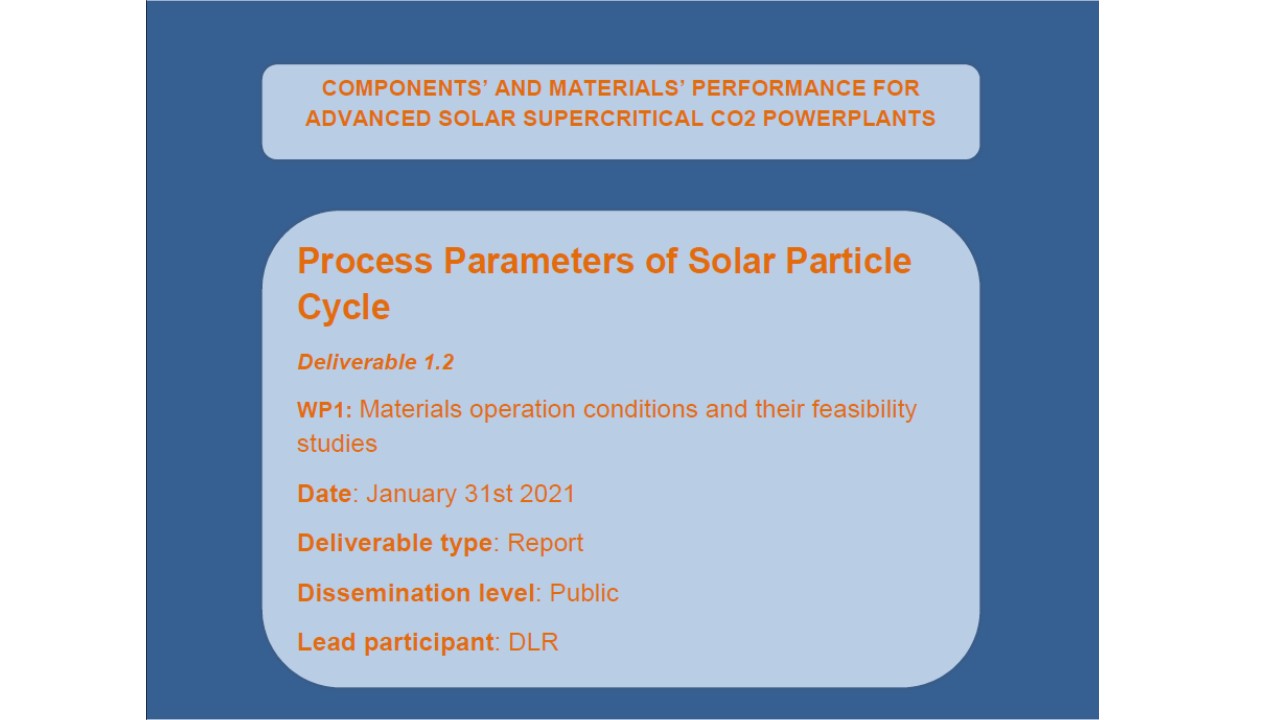
Deliverable 1.2 - Process Parameters of Solar Particle Cycle
The aim of this deliverable is to determine the operating conditions in the particle cycle, defined by the particle- sCO2 heat exchanger (HX), the solar field, the receiver and the thermal energy storage (TES) system. Under the second version, the heat exchanger design has been reviewed, namely sections: 3.2 (process parameters and technical limitations), 3.3 (material selection) and 3.4 (heat exchanger design).
March 2022
WP2 – Development and testing of particles

Deliverable 2.1 - Particle optimization by surface treatment
Four different techniques at three institutes were developed and tested on state-of-the-art and novel developed GEN3 particles. The initial optical performance could be improved in all the cases.
October 2022
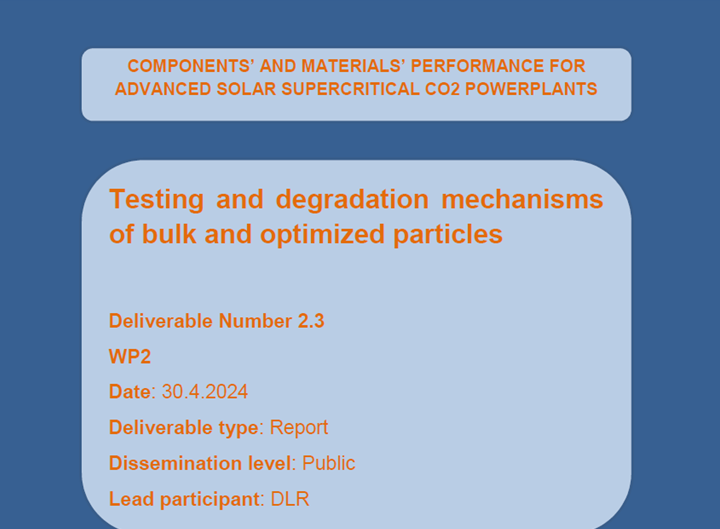
Deliverable 2.3 - Testing and degradation mechanisms of bulk and optimized particles
This deliverable describes the various durability tests conducted on the different particle types and their coatings examined within the CompassCO2 project. Four grades of bauxite based state-of-the-art proppants were used as reference particles. Saint-Gobain developed two generations of novel fused particles (consisiting of a mix of different oxides), and four generations of granulated paricles (of Fe2O3 based composition). The fourth generation of granulated particles is also called FerOx. In addition, three types of coatings have been developed by DLR, CIEMAT and DFI to boost solar absorptance. Further information on the novel particles types and their coatings can be found in Deliverables 2.1 and 2.2. The tests described in this deliverable can be divided into three categories: thermal tests (comprising static and cyclic exposure in furnaces), environmental tests (simulating the influence of humidity and freezing) and abrasion tests (at ambient and operational temperature). In the following chapters, each test condition and the obtained results for the different particle types are described in detail.
April 2024
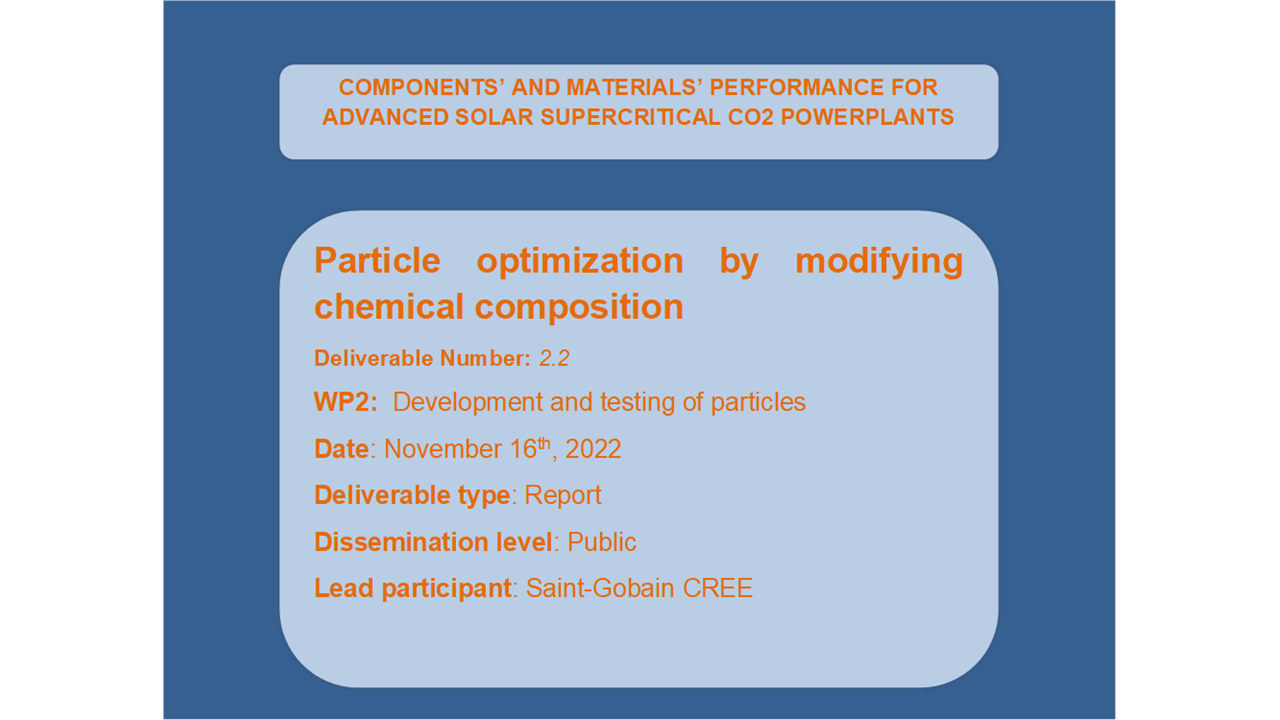
Deliverable 2.2 - Particle optimization by modifying chemical composition
Different generations of fused and granulated particles with improved mechanical properties were developed by Saint-Gobain and proposed to the partners. The granulated particles GEN4 present the best compromise in terms of performance versus cost
October 2022
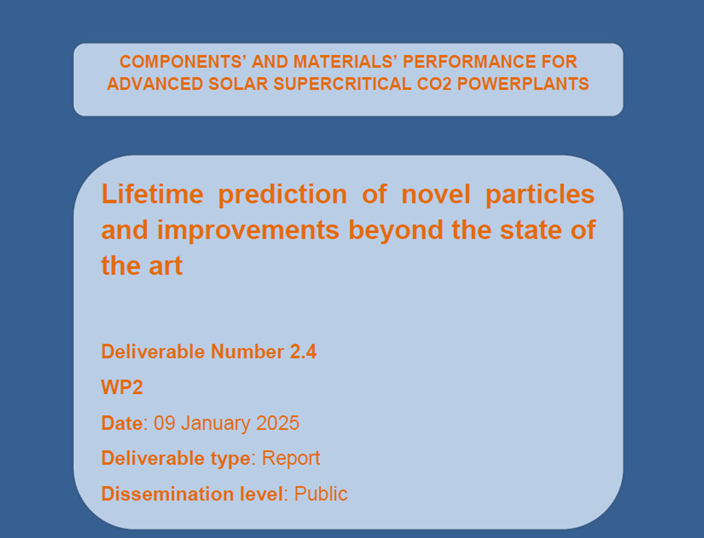
Deliverable 2.4 - Lifetime prediction of novel particles and improvements beyond the state of the art
This deliverable describes the modelling work that has been undertaken to better understand the particles and thereby assist in their design. This includes an analysis of the phase stabilities as a function of temperature, micromechanical response of individual particles including the effect of the underlying microstructure, as well as their mechanical behavior in tubular heat exchanger, thus representing realistic concentrated solar thermal (CST) application conditions.
This document presents the findings on the mechanical performance and lifetime prediction of novel particles to be used in advanced solar supercritical CO₂ power plants. Through computational modeling and experimental testing, we examined phase stability, micromechanical behavior, and fracture mechanisms of particles under extreme conditions, including high temperatures and mechanical stresses in heat exchangers. Our analyses, supported by thermodynamic calculations and discrete element simulations, identified critical factors influencing particle durability, such as microstructure, shape, and phase composition. The results provide valuable insights into the design of particle materials that can withstand the demanding operational conditions of CST applications, potentially enabling more efficient, durable, and carbon-neutral energy solutions.
January 2025
WP3 – Development of metals
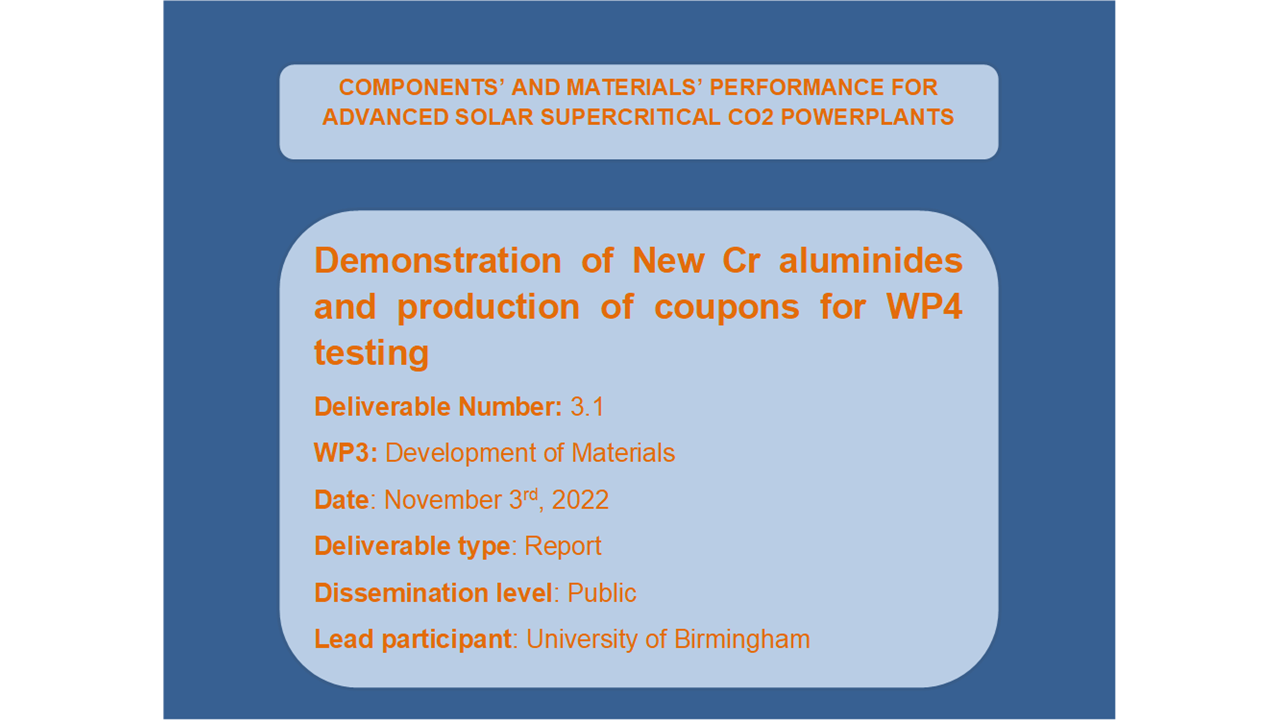
Deliverable 3.1 - Demonstration of New Cr aluminides and production as coupons for WP4 testing
Chromium-based superalloys are a desirable candidate material for the heat exchanger in the next generation of concentrated solar power (CSP). Chromium alloys appear to bear greater thermal stability over alternative high temperature materials such as nickel superalloys, cobalt superalloys and ferritic superalloys. Additionally, iron additions increase the hardness or the alloys and reduce age softening over their ternary alloy equivalent. Preliminary oxidation results show improved oxidation resistance of these alloys
October 2022

Deliverable 3.3 - Production of optimised steel / Ni substrates with advanced Cr aluminide/silicide coatings, coupons for WP4
For the targeted Cr-Si-based diffusion coatings, pack cementation is the current state-of-the art application process. Within the work of Deliverable 3.3 a new coating process was developed which utilizes a slurry technique to obtain a Cr-Si diffusion coating. This new process has the high potential to be both economically more viable and to meet the technical requirements for wear and oxidation-resistant coating for heat exchanger tubes of a concentrated solar power (CSP) plant with solid particles as heat collecting medium and supercritical CO2 on the power cycle.
April 2023
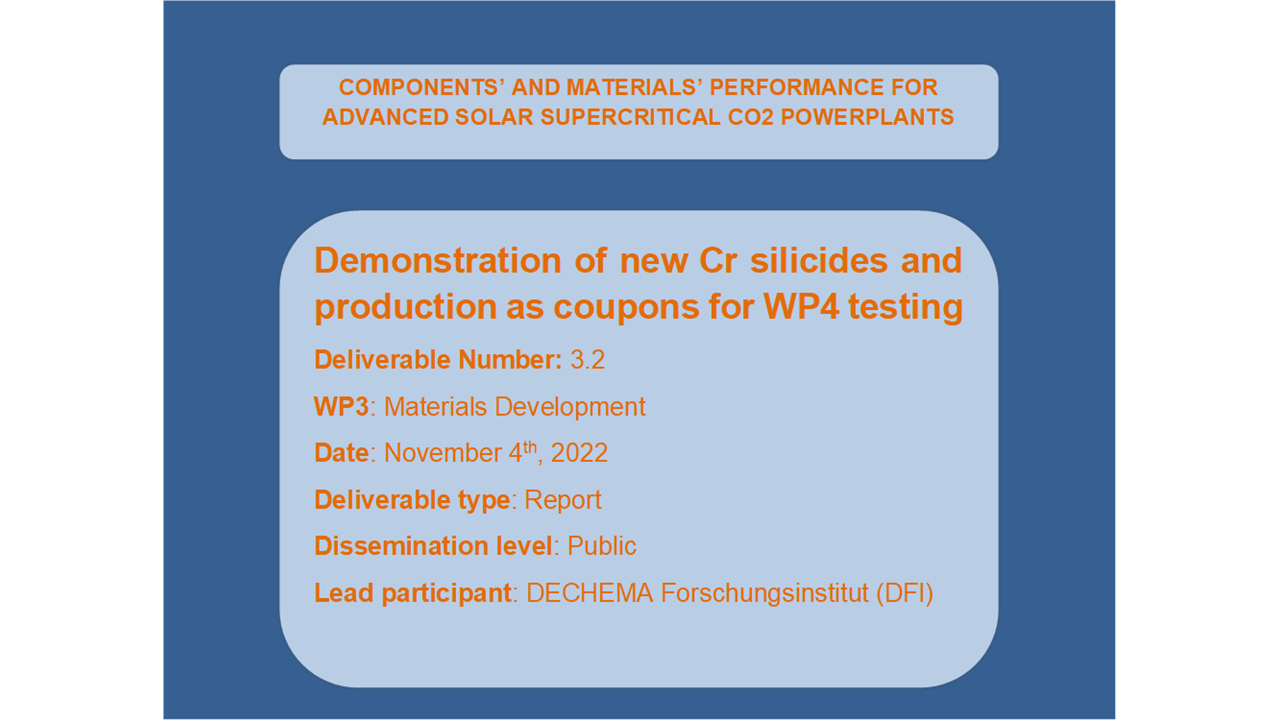
Deliverable 3.2 - Demonstration of New Cr silicides and production as coupons for WP4 testing
Cr-Si-alloys with a two-phase microstructure consisting of a toughening bcc-Crss-matrix and strengthening, hard A15-Cr3Si precipitates are promising materials for use in oxidative high temperature environments. However, Cr-Si alloys have some drawbacks, which are currently excluding them from any structural applications. The focus of the conducted investigations is the microstructure evolution and the influence of Fe and Ni. To investigate the influence of Fe and Ni to the DBTT and mechanical properties, compression tests at different temperatures were carried out.
October 2022
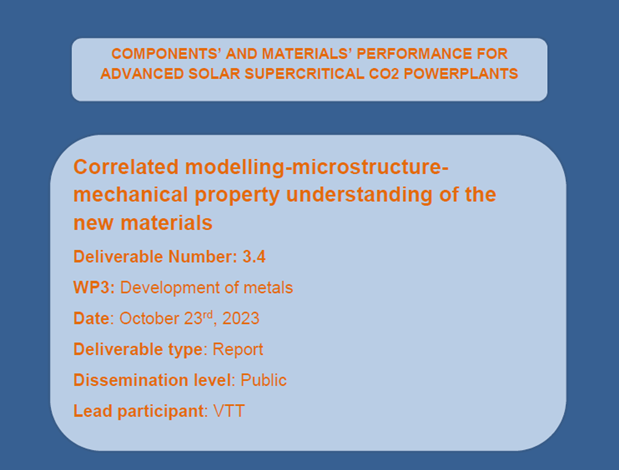
Deliverable 3.4 - Correlated modelling microstructure mechanical property understanding of the new materials
October 2023
WP4 – Evaluation and modeling of metal/medium interaction

Deliverable 4.1 - Performance in oxidizing and carburizing atmospheres (Version 1)
The investigations of oxidation and corrosion resistance were carried out in a test programme shared between FZJ, CIEMAT and CVR. The specimens were tested in air or CO2 (technical or high-purity gas) at elevated temperatures (between 600°C and 900°C). The materials were characterised in thermogravimetry experiments (FZJ), quasi-isothermal oxidation (CIEMAT), and cyclic oxidation (FZJ), with future high pressure autoclave (CVR) tests planned. In order to evaluate the oxide scale growth kinetics and the microstructural changes in the materials induced by oxidation/corrosion, post-exposure characterisation was performed mainly by optical metallography and SEM/EDS analysis of cross-sections of the specimens. The deliverable D 4.1 provides a comprehensive overview of the oxidation and CO2-corrosion testing results.
September 2023

Deliverable 4.1 - Performance in oxidizing and carburizing atmospheres (Version 2)
The investigations of oxidation and corrosion resistance were carried out in a test programme shared between FZJ, CIEMAT and CVR. The specimens were tested in air or CO2 (technical or high-purity gas) at elevated temperatures (between 600°C and 900°C). The materials were characterised in thermogravimetry experiments (FZJ), quasi-isothermal oxidation (CIEMAT), and cyclic oxidation (FZJ), with future high pressure autoclave (CVR) tests planned. In order to evaluate the oxide scale growth kinetics and the microstructural changes in the materials induced by oxidation/corrosion, post-exposure characterisation was performed mainly by optical metallography and SEM/EDS analysis of cross-sections of the specimens. The deliverable D 4.1 provides a comprehensive overview of the oxidation and CO2-corrosion testing results.
June 2025
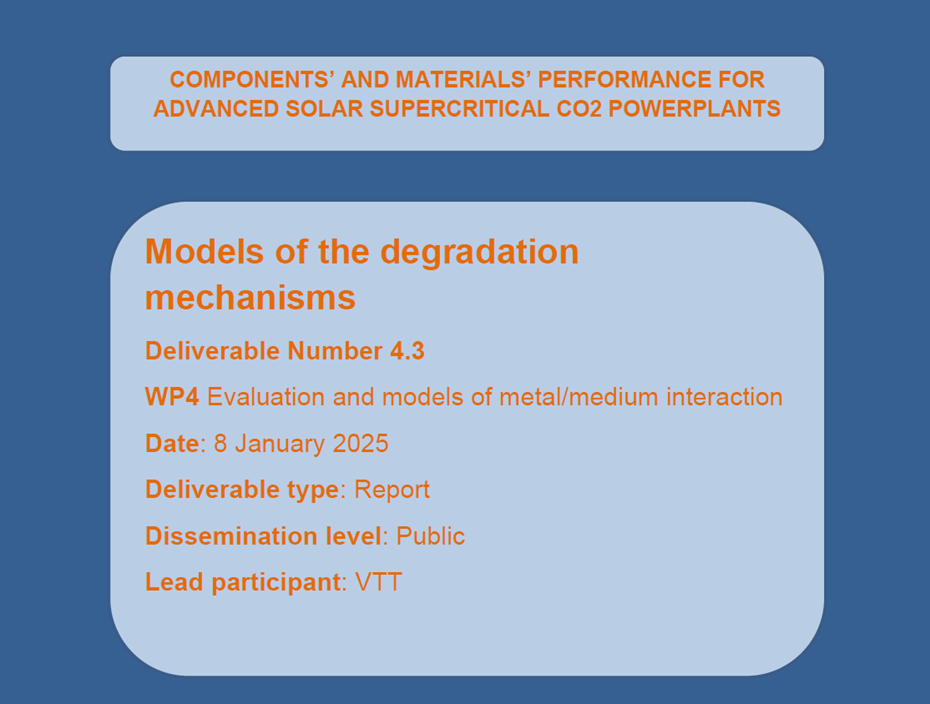
Deliverable 4.3 - Models of the degradation mechanisms
Based on the extensive Work Package 4 experimental campaigns carried out in Tasks 1 and 2, a modeling-based analysis is performed in Task 3, summarized in this report, Deliverable D4.3. This report provides a comprehensive overview of the degradation mechanisms in the heat exchanger tubes, and it also establishes a framework for lifetime estimation, drawing heavily on the experimental results carried out in this Work Package. The simulation analyses include high-fidelity finite element modelling, analytical contact mechanics, and discrete element method analyses.
January 2025
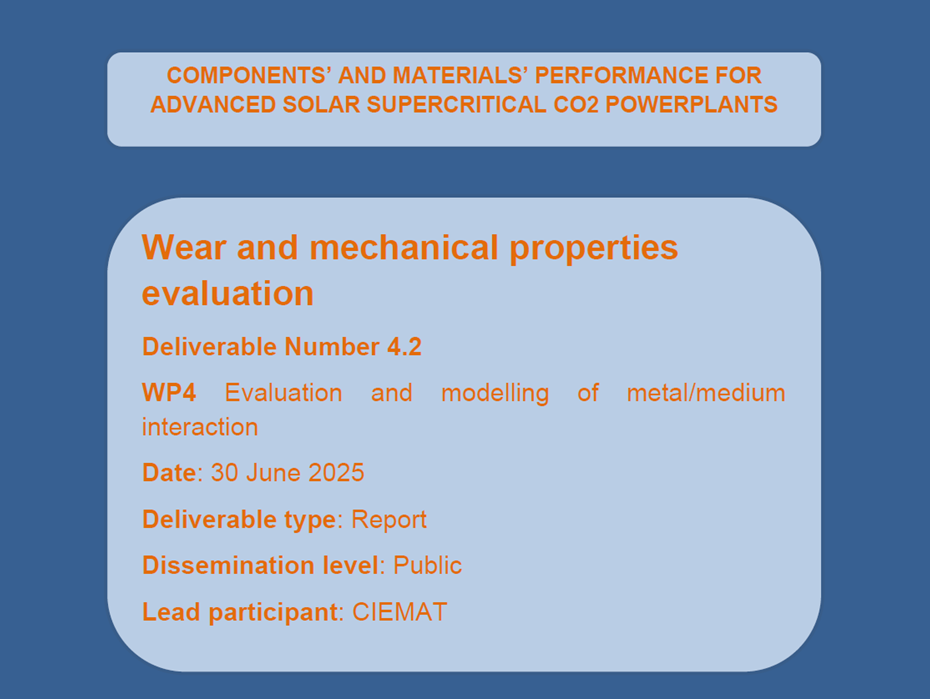
Deliverable 4.2 - Wear and mechanical properties evaluation
This report includes the experimental work and results obtained in the Task 4.1 regarding to the external wall investigation of the structural material and its interaction with the particles. The laboratory investigations, wear and creep tests and aim to understand the degradation mechanisms of these materials, in order to assess their performance. The main degradation expected is related to oxidation and corrosion protection, mechanical properties and wear. These properties have been studied with the State Of The Art (SOTA) materials and particles, used as reference, and the new particles developed in WP2 and the new bulk materials and coating developed in WP3. The laboratory tests are carried out under conditions simulating actual plant conditions. The degradation mechanisms of the materials are analysed in order to predict the lifetimes of the materials (heat carrier particles and heat exchanger components). The deliverable D 4.2 provides a comprehensive overview of the wear and mechanical properties testing results.
June 2025
WP5 – Technology validation
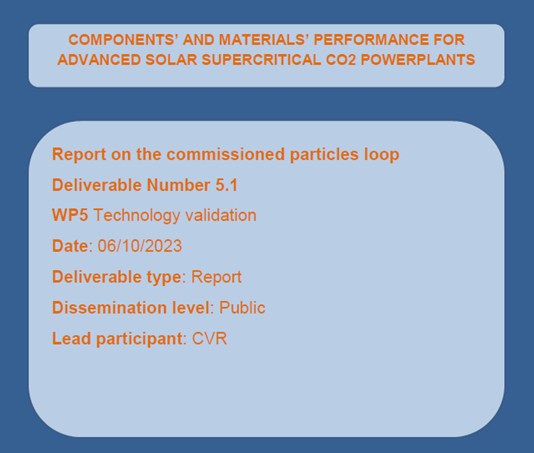
Deliverable 5.1 - Design summary of the commissioned particles loop
In pursuit of achieving the objectives outlined in WP5, which aims to test the particle heat exchanger under conditions relevant to the project, the implementation of both a hot particle loop and a sCO2 loop is necessary. The hot particle loop must fulfill several critical functions, including heating particles to temperatures as high as 800°C, conveying these heated particles with an appropriate mass flow rate, capturing the particles after passing through the test chamber and subsequently transferring them up to a container upstream of the heater. To meet these requirements and ensure the safe handling of particles at high temperatures within the loop, several subsystems have been thoughtfully designed, manufactured, and tested to validate the particle loop functionality. The particle loop as a whole, along with each of its individual subsystem are described in detail in their corresponding subsection, filled with comments and insights gathered during numerous experimental campaigns.
October 2023

Deliverable 5.4 - Evaluation of heat transfer and performance measurements of the HX (Task 5.4) to be used in the industrial design done in WP1
The objective of this document is to present the test measurements and the performance analysis. First, the measurements and test results are shown followed by the description of the different parameters required to assess the performance of the heat exchanger including its uncertainties. Finally, the performance results of the heat exchanger are shown and discussed. Furthermore, results of the impacts test on protective materials (Task 5.2.3) are included and discussed in the Annex.
April 2025

Deliverable 5.3 - Design summary of the manufactured particles/ s-CO2 heat exchanger
The objective of this document is to present key aspects of the design and manufacturing of the particles/sCO₂ heat exchanger mockup. This prototype was developed, manufactured, and tested at CVR with significant support of JCR and DLR during the design phase. The primary purpose of these tests is to demonstrate the operation of a system where two novel technologies at extreme operation conditions are integrated, providing valuable data on thermal performance and model validation.
April 2025
WP7 – Communication, dissemination and exploitation

Deliverable 7.2 - Communication and Dissemination Plan
This deliverable outlines the communication and dissemination activities performed within the framework of the COMPASsCO2 project. Different aspects are covered, targeting both internal (between the project partner and the European Commission (EC)) and external communication with all project stakeholders, including EC obligations regarding H2020 communication activities.
April 30th, 2021
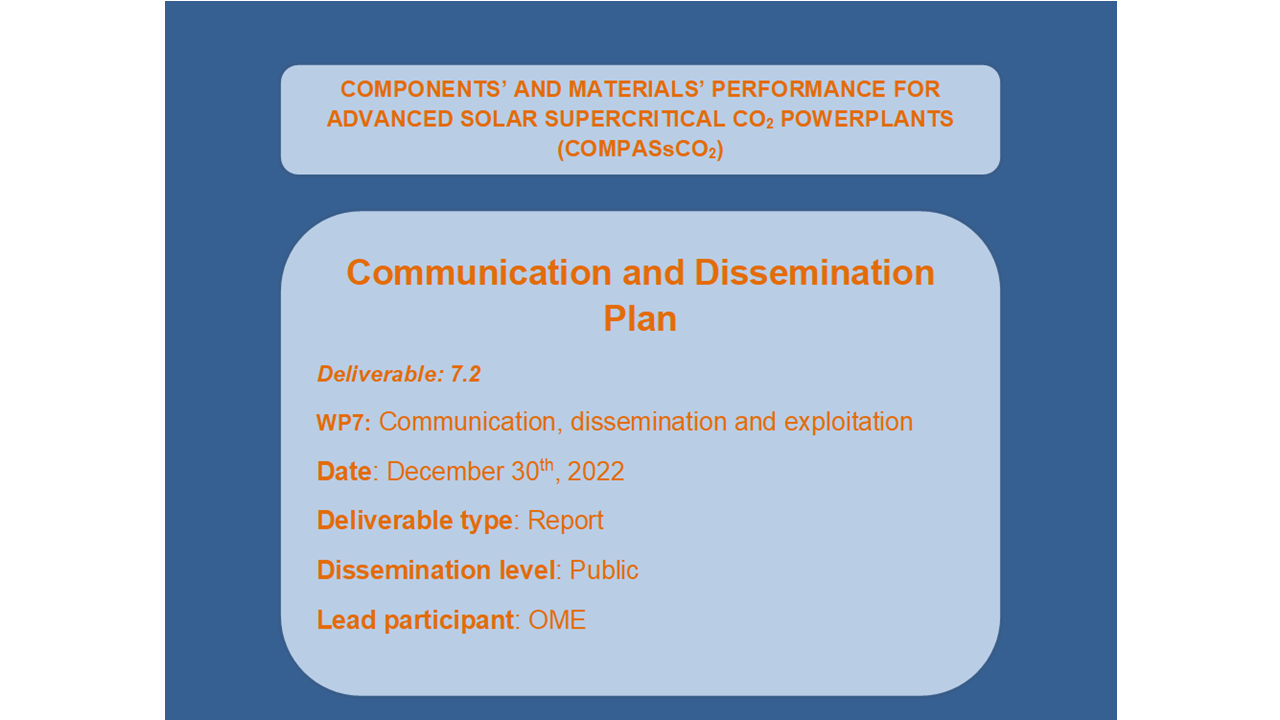
Deliverable 7.2 - Communication and Dissemination Plan
This deliverable outlines the communication and dissemination activities performed within the framework of the COMPASsCO2 project. Different aspects are covered, targeting both internal (between the project partner and the European Commission (EC)) and external communication with all project stakeholders, including EC obligations regarding H2020 communication activities. This is the second version of the plan that was initially developed in April 2021, following the first review of the project which was performed in spring 2022.
December 30th, 2022
